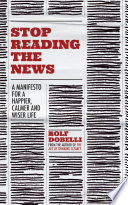

In today's digital age, the news is omnipresent, with updates available at our fingertips 24/7. The book emphasizes how this constant barrage of information can lead to anxiety, stress, and a skewed perception of reality. News outlets often prioritize sensationalism over substance, leading to a distorted view of the world. The author argues that this cycle can create a feedback loop where individuals feel compelled to stay informed, yet the information they consume is often negative and unproductive. By stepping back from the constant influx of news, readers can regain control over their mental well-being and focus on what truly matters in their lives.
Continue readingMany people believe that staying updated with the news makes them more informed citizens. However, the author challenges this notion by illustrating how the news often lacks depth and context. Headlines can be misleading, and the complexity of issues is frequently oversimplified. Instead of fostering genuine understanding, news consumption can lead to superficial knowledge. The book encourages readers to seek out deeper, more meaningful sources of information that contribute to their understanding of the world rather than relying on fleeting headlines and sound bites.
Continue readingIn a world filled with distractions, the book highlights the importance of cultivating focused attention. Constant news consumption divides our attention and hampers our ability to engage deeply with tasks, relationships, and personal growth. The author suggests that by reducing news intake, individuals can redirect their focus toward activities that foster creativity, productivity, and personal fulfillment. This shift can lead to a more intentional and meaningful life, where individuals invest their time and energy in pursuits that truly matter to them.
Continue readingJust as we are mindful of our physical diets, the book advocates for a conscious approach to our information consumption. The author encourages readers to curate their information diet by choosing high-quality, reliable sources and limiting exposure to sensationalist media. This involves setting boundaries around news consumption, such as designated times for checking news or opting for weekly summaries instead of daily updates. By being selective about the information we consume, we can create a healthier relationship with media and better support our mental and emotional well-being.
Continue readingSocial media platforms have transformed how we access and engage with news. The book discusses how algorithms prioritize sensational content and can create echo chambers that reinforce existing beliefs. This environment can lead to misinformation and polarized views. The author emphasizes the importance of critically assessing the information shared on social media and encourages readers to diversify their sources to gain a more balanced perspective. By recognizing the limitations of social media as a news source, individuals can make more informed choices about their media consumption.
Continue readingThe book argues that constant news consumption can disconnect individuals from their immediate surroundings and relationships. By focusing too much on global events, we may neglect the people and experiences in our own lives. The author advocates for a reconnection with reality by prioritizing face-to-face interactions, engaging with local communities, and investing time in personal relationships. This reconnection fosters a sense of belonging and fulfillment that can be lost in the noise of the news cycle.
Continue readingUltimately, the book encourages readers to seek meaning and purpose beyond the headlines. The author suggests that individuals can find fulfillment in personal projects, hobbies, and relationships that align with their values and passions. By stepping away from the news, readers can create space for introspection and personal growth. This shift allows individuals to engage with the world in a more meaningful way, focusing on actions that contribute to their well-being and the well-being of their communities.
Continue reading